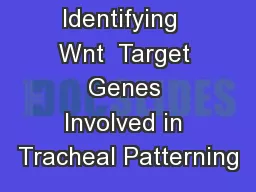

Lauren Leesman John Snowball Manoj Ambalavanan and Debora Sinner Honors Program Introduction Tracheal Patterning Patterning of Trachea Patterned on the dorsalventral axis Cshaped cartilaginous rings on ventral side smooth muscle on the dorsal side ID: 637193
Download Presentation The PPT/PDF document "Identifying Wnt Target Genes Involved ..." is the property of its rightful owner. Permission is granted to download and print the materials on this web site for personal, non-commercial use only, and to display it on your personal computer provided you do not modify the materials and that you retain all copyright notices contained in the materials. By downloading content from our website, you accept the terms of this agreement.
Slide1
Identifying Wnt Target Genes Involved in Tracheal Patterning
Lauren
Leesman,
John
Snowball, Manoj Ambalavanan and Debora Sinner
Honors ProgramSlide2
Introduction – Tracheal Patterning
Patterning of Trachea
Patterned on the dorsal-ventral axis.
C-shaped cartilaginous rings on ventral side, smooth muscle on the dorsal sideEnables protection, stability, and flexibility necessary
gene expression -
Tomato
ShhCre
miceSlide3
Introduction – Tracheomalacia
Tracheomalacia
Congenital disorder characterized by the underdevelopment of the trachea
Cartilaginous rings which are located on the ventral side are either flaccid or absentThose diagnosed with tracheomalacia can experience decreased air flow and have trouble breathingCan lead to trachea collapsing Other Abnormalities in patterningTracheal sleeve
Cartilaginous rings extending around the entire tracheaSlide4
Introduction – Goal
We know a fair amount about the patterning of the trachea
Little is known about how the patterning is established
Previous studies show significance of the Wntless gene (
Wls) its associated pathways help in understanding the embryonic development of tracheal patterning. Aim to identify the genes that are expressed in the developing trachea and mediate tracheal patterning. Slide5
How are Wnt ligands produced and how do they reach their target cells?
Wnt producing cell
HSPG
Lipoprotein particles
Wnt
Wnt
Wnt
Wnt
responsive/receiving cell
Canonical Pathway:
Cell fate determination
Non-Canonical Pathway:
Tissue polarity, cell movement
Wls
Porcnp
SCDSlide6
Previous Studies
Deleting
Wls
from the tracheal epithelium Slide7
Some genes of interest show expression in the respiratory tract as well as neural
.
Lgi
3
Sost
Cer1
Lrrc7Slide8
Wls target genes are expressed in discrete compartments of the trachea.
Whole mound showed respiratory tract expression- hard to tell dorsal/ventral patterning
RNA Scope allows to see more detailed expression pattern
Studying the expression of Notum in tracheal tissue in the frog
Lgi3 – dorsal expression
Notum
Wnt
5a
WlsSlide9
Genes modulated by epithelial wls signaling are potential
modulators of Wnt/
B
-catenin
signalingTop Flash Promoter in Luciferase Assays determined if target genes were intracellular modulators of
Wnt/B-catenin within the canonical Wnt signaling pathway. Also looking at extracellular by using the addition of Wnt3a. Slide10
Wnt
target genes are potential modulators of Sox9
Use of Sox9 Luciferase construct showed if genes were modulators of Sox9Slide11
Sox9ox
How cartilage is effected in over expression of Sox9
Overexpressed in epithelium using Sox9ox/
ShhCreOverexpressed in mesenchyme using Sox9ox/Dermo1Cre
Sox9ox/
ShhCre
Sox9ox/Dermo1Cre
Sox9ox/
ShhCre
ControlSlide12
conclusionsIdentified candidate genes never described before in respiratory tract that may play roles in tracheal patterning
Looking at target genes expression with RNA Scope
How target genes contribute to muscle and cartilage development in developing trachea Slide13
Personal reflection What I have learned
New techniques
Patience
Time managementHow to interpret challenging literature